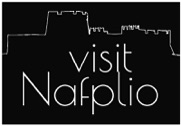PARALIO ASTROS
The coastal road that runs south from Nafplio, on the vest side of the Argolic bay, winds along beaches and mountains, interrupted by small villages, tempting for a coffee break and maybe a bath. This is one of the most beautiful coastal scenery we know of in Greece.
Soon after crossing the border of Arcadia county, you’ll see a village on your left, Xiropigado. The name means Dry Well, just in case you wondered about that. You can drive down to the sea and have a swim at the pebbly beach, or maybe eat fresh fish at one of the seaside taverns, our favourite is To Delfini. Xiropigado is a sweet, but quiet little place, so maybe you prefer to drive a little bit further, to Paralio Astros.
Paralio Astros (pictured above) is a really pretty beach and port village, with a long, beautiful sandy beach that attracts tourists from all over the Peloponnese. Along the (“Blue flag”) beach are pleasant cafes and taverns; in the back streets you’ll find shops and more cafes. In the north end of town a small hill rises up, with a castle on top (pictured left). The castle was built in connection with the Greek revolution in 1821, on top of the remains of a medieval castle. Inside the castle are three houses built by brothers who fought for Greece's freedom at this time.
If you walk along the beach towards the castle, you'll first pass the moored little fishing boats, then come to a small rocky beach, then to an amphitheatre of recent date, and finally to a small lighthouse and an even smaller chapel. The latter is devoted Profiti Ilias, and is only two or three square metres in size. Picnic tables and benches are placed outside, with wide views over the beautiful Argolis Bay.
Charming Paralio Astros is an excellent excursion from Nafplio, and a really charming town to spend some time in.
If you drive about 5 km inland, up the mountains, you'll come to Astros, the main town in the municipality, a fairly large and pleasant mountain village. Here you can visit the archaeological museum, which has many finds from the area.
Drive further up, on the road that leads to Ag. Sofia and Alea, and after about 3 km you reach Moní Loukóus / Metamorfosis Sotíros, a very well kept convent with a cloister garden that is a sight for, well, gods. The monastery is built on top of the ruins of an ancient sanctuary, and dates from the 12th century, although the monastery was established already in the 5th century. The church has beautiful frescoes and mosaic floors, and in the outer walls building materials derived from the sanctuary that was here before can be seen.
Just outside the entrance area to the monastery, we find the remains of what is probably a Roman aqueduct, and across the road from the monastery archaeologists are still working on excavations of the town of Eva, an important Roman city. Here, they have among other things, found a large villa, which was the "summer house" of Herodes Atticus. He was a Greek, philanthropist, aristocrat and senator, who collected art, provided important public buildings (like the Herodes Atticus Theatre at the foot of the Acropolis in Athens), and wrote books. Just to mention a few things.
Continue to further up the mountain, if you like, to Alea and Tegea and/or North Kynouria.
A charming village, a garden for gods

Paralio Astros is located in the county of Arcadia, 30 km from Nafplio.
Paralio Astros (above), Xiropigado (below).
The main beach in Paralio Astros (above), and the castle (below).
The beautiful garden in Moní Loukóus / Metamorfosis Sotíros.
